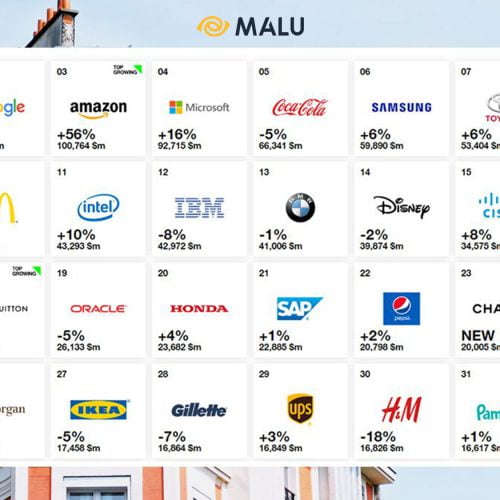
With today’s fiercely competitive market, it is very important to build a Brand Image – a successful brand image . This is a bridge between businesses and customers, helping businesses increase revenue from business activities and maintain a strong position in the market to beat competitors. The stronger the brand image, the greater the customer’s perception and impression of the brand. Since then, businesses have more opportunities to develop stronger in the market.
So what is Brand Image? How to build a strong brand image for the business? Malu will clarify your questions through the article below!
1. Brand Image – What is a brand image?
Brand Image – Brand image is the first thing that pops up when people think of a business or its products. Brand image consists of more elements than businesses think. “Image” here is not merely a visual visual image, but also includes intangible factors such as value and quality.

Every customer interaction with the brand at any touchpoint will contribute to the shaping of the brand image. From social media impressions, to purchasing patterns and building customer service experiences, all interactions affect how a person thinks and talks about a brand.
Since each person will have different interactions with the brand, shaping and maintaining a consistent brand image is not easy. But, if you really take the time to find out what your customers are thinking about your brand, you can learn how to actively build and promote your brand. Why is brand image important, or how does it link to brand identity? And how to measure the effectiveness of brand image?
2. What is the difference between Brand Identity and Brand Image?
| Brand identity | Brand image (Brand image) |
| Is how a business wants consumers to perceive it in the marketplace. | It is how customers feel about your business and how they perceive it. |
| Active nature, in your hands to be established. | Passive nature, completely out of your control to build it. |
| Include elements like logo, slogan, tagline, style and tone, etc. | Include brand elements and brand associations with customers. |
| The reality of a brand. | Is the perception of current and potential customers about the brand. |
| Much depends on how it is presented by the business. | Based on the customer’s experience with the brand is mainly. |
| Focus on reviewing, looking back. | Focus on what happens next. |
| Represents the aspirations of a business. | Represent others’ views of the brand. |
| Durable, long lasting. | Outwardly. |
| Represents business promises to consumers. | Is the customer’s perception of the brand after the experience. |
Brand Identity – Brand Identity is built internally. Basically, it is the way the brand wants to be seen by the customers, because it is designed and controlled directly by the brand. For example, a company can present itself to customers through elements such as identity colors, logos, websites, etc. It is how the brand presents itself. Thus, brand identity means the process of establishing, adjusting and shaping an image of oneself.

On the other hand, Brand Image is how customers actually feel about the brand, and it is an external factor. You have little control over your brand image, but it’s also an essential part of looking at the overall health of your brand. The ideal case is when the brand image is synchronized with the identity, but often the brand image is constantly changing because the customer’s perception of the brand will change over time.
3. Brand Image and Brand Awareness
These are also two concepts that have some similarities and are often confused with each other. Brand Image – Brand Image depicts brand perception across customer touchpoints, which can be positive, negative (or neutral), and often have an impact on consumers’ relationship with the brand. brand.

In contrast, Brand Awareness is simply measuring the level of awareness of a brand by customers. Customers have never heard of the brand name, or the brand has ever been mentioned in the customer’s mind, or among thousands of names, can consumers recognize the brand; Those are questions for brand awareness.
4. Why Brand Image – Brand image is important?
When consumers decide to withdraw their wallet for anything from a brand, they not only buy the product, they also buy the experience and the brand image. To create a convincing brand value for customers, businesses need to make their brand image clear, through products and services and through the way businesses express themselves with brand identity, media tone.
Effort and investment in brand image will build brand equity, which is the additional value a business receives when it has a recognizable name compared to other competitors. A business with a valuable brand will have an easier time retaining customers, increasing product prices, or launching new products to the market. A good brand image, of course, will help increase brand value.
4.1 A good brand image creates a good impression on customers
In communication, first impressions are not always right, but it greatly affects how we perceive a person. Likewise with the relationship between the customer and the brand, all customer likes and dislikes stem from the first contact with the brand (whether direct or indirect). In order for the brand image to be properly established, the brand needs to be present in a subtle way through every touch point (website, business card, storefront, etc.).
There are many ways to approach customers with flair and intelligence. For example, Red Bull has a brand image associated with selling exhilarating experiences rather than selling energy drinks. Their customer touchpoints are all related to sports or extreme games, so people subconsciously associate Red Bull with a feeling of excitement.
4.2 Brand image builds trust in customers
A stable brand image will bring peace of mind and build customer loyalty to the brand. When customers know what they can expect from a brand, they will search for products and services based on their existing associations and images of the brand. According to statistics, 3 out of 5 people say that they would prefer to buy products from a known brand instead of an unfamiliar one.
For example, Toshiba has built its brand image on familiarity and reliability. When buying a washing machine or refrigerator, users often choose Toshiba because they already know what to expect from this brand. It is a trusted name with the above product categories.
4.3 Brand image helps brands gain recognition
As we discussed the difference between Brand Image and Brand Awareness, these two definitions are still somewhat related to each other. It is not easy for a brand to completely “stand out” – to stand out, especially at a time when customers are already “oily” with shocking media. Standing out is no longer a dominant player, but striking is the sophistication and consistency of the brand image in every touch point and customer experience. They range from brand story, communication, identity image, media image, to sales service, shipping and customer care.
>>> What is Brand Positioning? Building Brand Positioning Strategy
When customers have more choices, it means more competition, but it also means that customers will be smarter, with more taste. It requires businesses to be really dedicated, invest effort in products and brands, but it is also the things that customers will appreciate and engage with.
4.4 Brand image creates brand reputation and value
Brand image is paramount in creating a brand and value for a business. This is by no means an exaggeration – too loud marketing can make a brand reach many people, but whether they buy the product or stay with the brand depends on how the business builds its image for the brand. brand. Therefore, the core point is still the product quality and the image that the brand brings to customers, it is they that create loyal customers that bring long-term sales.
4.5 Strong brand image helps businesses grow
Of course, a strong brand image means more profits, as new customers are attracted to the effects of the brand. However, the ultimate benefit of a good brand image is more than just increased sales and profits. Brand image also helps reduce costs and increase efficiency in later marketing steps. For example, when introducing a new product, it is easier if the brand already has an impressive image and reputation, customers will be more willing to try a new product if the new product is from a brand they have always trusted and trusted. respect in advance.
We think these are completely compelling reasons for businesses to consider branding and more than consider reviewing and measuring their brand image, to know if that image has been effective. effective and consistent with business goals. And to better understand the brand image and its influence, we would like to introduce some brands with successful images.
5. The process of forming the brand image of the business
5.1. Marketing Communication
Marketing communication is an activity that businesses can actively express and communicate their brand identity. The consumer’s perception of the brand image can gradually change thanks to advertising, and the business can direct it in the direction of the brand identity. The marketing communication process also helps the brand identity and image to be consistent with each other. Besides, it also plays an important role in conveying messages from businesses to consumers and affects brand image.
5.2. Consumer experience
To form a brand image, the consumer experience also plays an equally important role because of its strong and positive influence on consumers such as marketing communication. However, consumer experience and promotional factors should not contradict each other. From receiving advertising messages to consuming products, they need to work closely together so that consumers have a clear image of the brand. If the actual consumer experience is different from the marketing message, it will cause the brand image to change in the eyes of the user, even in a negative direction. Therefore, marketing communication needs to be done honestly so that customers experience the reality more authentically and reliably.
5.3. Social influence
Word of mouth is also considered a powerful communication tool, influencing consumers and having the ability to spread “one word ten, ten to one hundred” as it is a discussion between two or more people. Opinions about good brand image by word of mouth are said to be more prestigious than other communication methods. If before, word of mouth was limited by time and physical distance, now, thanks to social media, what you share can reach millions of users in just a few days. second. This is considered a factor that triggers the needs of potential customers and affects the user’s mind about the brand image. So, social influence can influence the thoughts, views, and beliefs about products of potential and existing customers.
6. How to build a strong brand image for your business
To be able to build a professional brand image and easily reach customers, let’s take a look at how to create a strong brand image with Malu as follows:

6.1. Defining the vision, mission and core values of the business
This is the first step in the process of building the brand image of the business. Clearly defining vision, mission and core values will help businesses unify activities later. The value of inconsistent activities will affect the image of the business. The original messages and goals set out before construction will also not be possible.
Therefore, businesses should clearly define the mission that needs to be completed, have a vision for future development and the value that the business brings to customers. From there, step by step build a more perfect corporate image.
6.2. Define target audience
When you clearly define who your target audience is, what habits you have, what your personality is like, what your interests are, etc., then the business will bring to that audience the right messages. To be able to clearly identify target customers, businesses need to research using many different methods. Specifically, businesses can collect by interviewing, surveying, etc. to know the demographic and psychological characteristics of target customers. Thereby building a suitable brand image and easily leaving a deep impression on customers.
6.3. Brand positioning statement
This can be seen as a statement of the value of the business associated with the product or service to the customer. This statement is the special feature of the business compared to competitors in the market. Through this way, you can convey to the target audience that your business can solve all the problems customers are facing.
To be able to declare brand positioning, businesses need to identify the strengths of their business. Next is competitor research. Thanks to that, businesses can know what their advantages are over competitors and build an appropriate brand positioning strategy. Besides, businesses can also create unique and attractive brand stories to make a strong impression on customers.
6.4. Build brand personality
Brand personality is very important in the process of building a brand image . This is something you can show your customers what really sets you apart and stands out. How are those differences externalized? The brand personality of the business will be used throughout all communication activities and identity images in the future. Therefore, when creating a brand personality, it is necessary to be in line with the business goals of each industry, each business.
6.5. Building a consistent brand image
Each business will have its own set of brand identity to help customers identify the brand, identify the products and services of the business.
The elements that make up the brand image include: logo, text, icon image, color, representative face, etc. have the brand’s own characteristics. Thanks to these factors, customers can identify the brand easily and quickly.
Therefore, when building communication strategies, businesses need to stick to and clearly show the brand image to increase customer awareness. Small details that can help position the brand of the business to the public. The image of the business based on that also becomes more professional and impressive.
6.6. Measure brand image
After creating a brand image, businesses need to measure brand image to know how customers perceive the image. To measure, businesses will conduct online surveys or meet in person with customers, employees or partners to conduct a survey on brand awareness . The results obtained will be an important source of data for businesses to make appropriate directions in the future.
7. Effective channels to promote brand image
After you have thoroughly researched and laid the foundation for your brand image, you can strengthen your brand image activities to build a loyal following and generate sales. row. To do that, businesses can do it by integrating brand channels together to promote their brand on a large scale:

- Website: Building a brand image through a website is very important for businesses. Because you can use your website to promote your brand, build your brand’s reputation and authority. Besides, they also increase the visibility and awareness of the customer’s brand.
>> See more: What is a website? The role of the website with the business
- Content: This is the driving force behind integrated digital marketing activities. Thereby enhancing its brand profile. Businesses will need to deliver a steady stream of blog posts, contributor articles, and other rich content to target audience segments.
>> See more: What is Content Marketing? Common Types of Content Marketing
- Social: This is a valuable tool for sharing information related to your industry, increasing engagement with customers and influencers in your field. A strong brand presence on social media can significantly increase website traffic and enhance your brand image with both new and existing customers.
- SEO: Search engine optimization ( SEO ) is a solution that helps improve the ranking of a business on popular search engines like Google. To make a deep impression on your customers’ minds, you’ll need to rank well for specific keywords and key phrases that drive traffic to your business website and other digital platforms.
- Paid Marketing: This is a very effective brand image promotion channel. They help build brand awareness with target customers on platforms they trust. A sophisticated paid marketing strategy can easily reach detailed audience segments to directly influence purchasing behavior.
- Email Marketing : Email is a valuable channel for maximizing ROI . With strategic use, email will help you deliver the right content to your target audience.
- Influencer / KOL : They are influential people in a certain field, their opinions have a certain impact on a large number of interested people. Influencers can be singers, actors, professionals, bloggers or video writers. They are influential and can convey messages to the public quickly.
- PR/ Event : This is a brand promotion channel that helps businesses disseminate key messages and news on online blogs, trade publications and news outlets. PR also helps to improve brand image and increase customer awareness.
Companies with impressive and successful brand images
Apple

Apple is a great example of how a brand can be creative and carefully change its brand image over time. For example, recently, few people even describe Apple with adjectives like “innovative” or “disruptive”; users gradually consider Apple as a “trustworthy” and “close” brand. Previous marketing campaigns often carried the tagline “thinking different”, but more recently, like the apocalyptic ad for WWDC 2017, Apple sarcastic about its dependence on technology.
Coca Cola

More than just a business with consumer products, Coca-Cola has succeeded in attracting a loyal and cult following. The success of the brand is thanks to the ability to speak for customers to speak their hearts, selling experiences instead of just a drink. Through attractive advertisements with celebrities and focus on customers, the brand always tries to convey the image of joy.
Zappos

Online clothing and footwear retailer Zappos is widely known as a fun, creative brand, even though its parent company, Amazon, doesn’t have a similar image. The key to Zappos’s success is communicating through visual actions; they actually practice what they say (Culture Playbook product guides user interaction, focusing on engaging each interaction instead of ads with empty words)
Conclude
Hopefully the above sharing has helped you better understand what Brand Image is. In short, brand image was soon concerned by managers because this is the bridge between customers and businesses. They make a deep impression in the minds of customers and also help the business to keep a foothold in the market to beat the competition.







